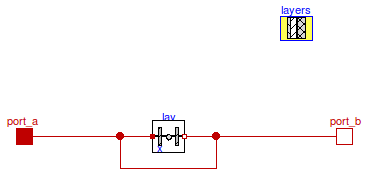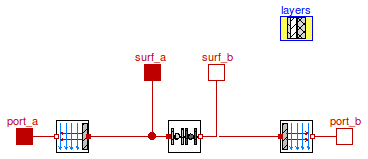| Name | Description |
|---|---|
| User's Guide | |
| Model for single layer heat conductance | |
| Model for heat conductance through a solid with multiple material layers | |
| Model for a convective heat transfer | |
| Model for an opaque construction such as a wall, floor or ceiling | |
| Data for heat transfer models | |
| Functions for heat transfer package | |
| Collection of models that illustrate model use and test models | |
| Package with base classes for HeatTransfer package |
 Buildings.HeatTransfer.ConductorSingleLayer
Buildings.HeatTransfer.ConductorSingleLayer

The construction has material.nSta ≥ 1 state variables. The state variables are connected to each other through thermal conductors. There is also a thermal conductor between the surfaces and the outermost state variables. Thus, to obtain the surface temperature, use port_a.T (or port_b.T) and not the variable T[1].
The thickness of the construction is divided into nLay ≥ 1 layers of equal material properties. To build multi-layer constructions, use Buildings.HeatTransfer.ConductorMultiLayer.
Extends from Buildings.HeatTransfer.BaseClasses.PartialConductor (Model for heat conductor).
| Type | Name | Default | Description |
|---|---|---|---|
| Area | A | Heat transfer area [m2] | |
| ThermalResistance | R | if (material.R == 0) then ma... | Thermal resistance of construction [K/W] |
| Material | material | redeclare parameter Data.Bas... | Material from Data.Solids or Data.Resistances |
| Initialization | |||
| Boolean | steadyStateInitial | false | =true initializes dT(0)/dt=0, false initializes T(0) at fixed temperature using T_a_start and T_b_start |
| Temperature | T_a_start | 293.15 | Initial temperature at port_a, used if steadyStateInitial = false [K] |
| Temperature | T_b_start | 293.15 | Initial temperature at port_b, used if steadyStateInitial = false [K] |
| Type | Name | Description |
|---|---|---|
| HeatPort_a | port_a | Heat port at surface a |
| HeatPort_b | port_b | Heat port at surface b |
model ConductorSingleLayer "Model for single layer heat conductance"
extends Buildings.HeatTransfer.BaseClasses.PartialConductor(
final R=if (material.R == 0) then material.x/material.k/A else material.R/A);
// if material.R == 0, then the material specifies material.k, and this model specifies x
// For resistances, material.k need not be specified, and hence we use material.R
// The value T[:].start is used by the solver when finding initial states
// that satisfy dT/dt=0, which requires solving a system of nonlinear equations
// if the convection coefficient is a function of temperature.
Modelica.SIunits.Temperature T[nSta](start=
{T_a_start+(T_b_start-T_a_start) * UA * sum(1/G[k] for k in 1:i) for i in 1:nSta})
"Temperature at the states";
Modelica.SIunits.HeatFlowRate Q_flow[nSta+1]
"Heat flow rate from state i to i+1";
replaceable parameter Data.BaseClasses.Material material
"Material from Data.Solids or Data.Resistances";
parameter Boolean steadyStateInitial=false
"=true initializes dT(0)/dt=0, false initializes T(0) at fixed temperature using T_a_start and T_b_start";
parameter Modelica.SIunits.Temperature T_a_start=293.15
"Initial temperature at port_a, used if steadyStateInitial = false";
parameter Modelica.SIunits.Temperature T_b_start=293.15
"Initial temperature at port_b, used if steadyStateInitial = false";
protected
parameter Modelica.SIunits.HeatCapacity C = A*material.x*material.d*material.c/material.nSta
"Heat capacity associated with the temperature state";
// nodes at surface have only 1/2 the layer thickness
final parameter Modelica.SIunits.ThermalConductance G[nSta+1]={
UA*nSta * (if (i==1 or i==(nSta+1)) then 2 else 1) for i in 1:nSta+1}
"Thermal conductance of layer between the states";
Modelica.SIunits.TemperatureSlope der_T[nSta]
"Time derivative of temperature (= der(T))";
final parameter Integer nSta(min=1) = material.nSta
"Number of state variables";
initial equation
// The initialization is only done for materials that store energy.
if not material.steadyState then
if steadyStateInitial then
der_T = zeros(nSta);
else
for i in 1:nSta loop
T[i] = T_a_start+(T_b_start-T_a_start) * UA * sum(1/G[k] for k in 1:i);
end for;
end if;
end if;
equation
port_a.Q_flow = +Q_flow[1];
port_b.Q_flow = -Q_flow[nSta+1];
Q_flow[1] = G[1] * (port_a.T-T[1]);
Q_flow[nSta+1] = G[nSta+1] * (T[nSta] -port_b.T);
for i in 2:nSta loop
// Q_flow[i] is heat flowing from (i-1) to (i)
Q_flow[i] = G[i] * (T[i-1]-T[i]);
end for;
if material.steadyState then
der_T = zeros(nSta);
for i in 2:nSta+1 loop
Q_flow[i] = Q_flow[1];
end for;
else
for i in 1:nSta loop
der(T[i]) = (Q_flow[i]-Q_flow[i+1])/C;
der_T[i] = der(T[i]);
end for;
end if;
end ConductorSingleLayer;
 Buildings.HeatTransfer.ConductorMultiLayer
Buildings.HeatTransfer.ConductorMultiLayer

To obtain the surface temperature of the construction, use port_a.T (or port_b.T) and not the variable T[1] because there is a thermal resistance between the surface and the temperature state.
To model a single layer material, use Buildings.HeatTransfer.ConductorSingleLayer.
Extends from Buildings.HeatTransfer.BaseClasses.PartialConductor (Model for heat conductor), Buildings.HeatTransfer.BaseClasses.PartialConstruction (Partial model for constructions with and without convective heat transfer coefficient).
| Type | Name | Default | Description |
|---|---|---|---|
| Area | A | Heat transfer area [m2] | |
| ThermalResistance | R | sum(lay[:].R) | Thermal resistance of construction [K/W] |
| Generic | layers | redeclare parameter Building... | Construction definition from Data.OpaqueConstructions |
| Initialization | |||
| Boolean | steadyStateInitial | false | =true initializes dT(0)/dt=0, false initializes T(0) at fixed temperature using T_a_start and T_b_start |
| Temperature | T_a_start | 293.15 | Initial temperature at port_a, used if steadyStateInitial = false [K] |
| Temperature | T_b_start | 293.15 | Initial temperature at port_b, used if steadyStateInitial = false [K] |
| Type | Name | Description |
|---|---|---|
| HeatPort_a | port_a | Heat port at surface a |
| HeatPort_b | port_b | Heat port at surface b |
model ConductorMultiLayer
"Model for heat conductance through a solid with multiple material layers"
extends Buildings.HeatTransfer.BaseClasses.PartialConductor(
final R=sum(lay[:].R));
Modelica.SIunits.Temperature T[sum(nSta)] "Temperature at the states";
Modelica.SIunits.HeatFlowRate Q_flow[sum(nSta)+nLay]
"Heat flow rate from state i to i+1";
extends Buildings.HeatTransfer.BaseClasses.PartialConstruction;
protected
ConductorSingleLayer[nLay] lay(
each final A=A,
material = layers.material,
T_a_start = _T_a_start,
T_b_start = _T_b_start,
each steadyStateInitial = steadyStateInitial) "Material layer";
protected
parameter Modelica.SIunits.Temperature _T_a_start[nLay](fixed=false)
"Initial temperature at port_a of respective layer, used if steadyStateInitial = false";
parameter Modelica.SIunits.Temperature _T_b_start[nLay](fixed=false)
"Initial temperature at port_b of respective layer, used if steadyStateInitial = false";
initial equation
for i in 1:nLay loop
_T_a_start[i] = T_b_start+(T_a_start-T_b_start) * 1/R * sum(lay[k].R for k in i:nLay);
_T_b_start[i] = T_a_start+(T_b_start-T_a_start) * 1/R * sum(lay[k].R for k in 1:i);
end for;
equation
// This section assigns the temperatures and heat flow rates of the layer models to
// an array that makes plotting the results easier.
for i in 1:nLay loop
for j in 1:nSta[i] loop
T[sum(nSta[k] for k in 1:(i-1)) +j] = lay[i].T[j];
end for;
for j in 1:nSta[i]+1 loop
Q_flow[sum(nSta[k] for k in 1:i-1)+(i-1)+j] = lay[i].Q_flow[j];
end for;
end for;
connect(port_a, lay[1].port_a);
for i in 1:nLay-1 loop
connect(lay[i].port_b, lay[i+1].port_a);
end for;
connect(lay[nLay].port_b, port_b);
end ConductorMultiLayer;
 Buildings.HeatTransfer.Convection
Buildings.HeatTransfer.Convection

Extends from Buildings.BaseClasses.BaseIcon (Base icon).
| Type | Name | Default | Description |
|---|---|---|---|
| Area | A | Heat transfer area [m2] |
| Type | Name | Description |
|---|---|---|
| HeatPort_a | solid | |
| HeatPort_b | fluid |
model Convection "Model for a convective heat transfer"
extends Buildings.BaseClasses.BaseIcon;
import c = Buildings.HeatTransfer.Functions.ConvectiveHeatFlux;
replaceable function qCon_flow =
Buildings.HeatTransfer.Functions.ConvectiveHeatFlux.constantCoefficient
constrainedby
Buildings.HeatTransfer.Functions.ConvectiveHeatFlux.BaseClasses.PartialConvectiveHeatFlux(
dT=dT) "Function for convective heat transfer coefficient";
parameter Modelica.SIunits.Area A "Heat transfer area";
Modelica.SIunits.HeatFlowRate Q_flow "Heat flow rate from solid -> fluid";
Modelica.SIunits.TemperatureDifference dT(start=0) "= solid.T - fluid.T";
Modelica.Thermal.HeatTransfer.Interfaces.HeatPort_a solid;
Modelica.Thermal.HeatTransfer.Interfaces.HeatPort_b fluid;
equation
dT = solid.T - fluid.T;
solid.Q_flow = Q_flow;
fluid.Q_flow = -Q_flow;
// Even if hCon is a step function with a step at zero,
// the product hCon*dT is differentiable at zero with
// a continuous first derivative
Q_flow = A*qCon_flow();
end Convection;
 Buildings.HeatTransfer.ConstructionOpaque
Buildings.HeatTransfer.ConstructionOpaque

To compute heat conduction in the solid, this model uses an instance of Buildings.HeatTransfer.ConductorMultiLayer. See Buildings.HeatTransfer.ConductorMultiLayer for how to define constructions that can be used with this model. The convective heat transfer is computed using the model Buildings.HeatTransfer.Convection.
Extends from Buildings.BaseClasses.BaseIcon (Base icon), Buildings.HeatTransfer.BaseClasses.PartialConstruction (Partial model for constructions with and without convective heat transfer coefficient).
| Type | Name | Default | Description |
|---|---|---|---|
| Area | A | Heat transfer area [m2] | |
| Generic | layers | redeclare parameter Building... | Construction definition from Data.OpaqueConstructions |
| Initialization | |||
| Boolean | steadyStateInitial | false | =true initializes dT(0)/dt=0, false initializes T(0) at fixed temperature using T_a_start and T_b_start |
| Temperature | T_a_start | 293.15 | Initial temperature at port_a, used if steadyStateInitial = false [K] |
| Temperature | T_b_start | 293.15 | Initial temperature at port_b, used if steadyStateInitial = false [K] |
| Advanced | |||
| CoefficientOfHeatTransfer | hCon_a_start | 3 | Convective heat transfer coefficient on side a, used to compute initial condition [W/(m2.K)] |
| CoefficientOfHeatTransfer | hCon_b_start | hCon_a_start | Convective heat transfer coefficient on side b, used to compute initial condition [W/(m2.K)] |
| Type | Name | Description |
|---|---|---|
| HeatPort_a | port_a | Heat port at outside of air boundary layer near surface a |
| HeatPort_b | port_b | Heat port at outside of air boundary layer near surface b |
| HeatPort_a | surf_a | Heat port at surface a |
| HeatPort_b | surf_b | Heat port at surface b |
model ConstructionOpaque
"Model for an opaque construction such as a wall, floor or ceiling"
extends Buildings.BaseClasses.BaseIcon;
extends Buildings.HeatTransfer.BaseClasses.PartialConstruction;
parameter Modelica.SIunits.Area A "Heat transfer area";
final parameter Modelica.SIunits.CoefficientOfHeatTransfer U = UA/A
"U-value (without surface heat transfer coefficients)";
final parameter Modelica.SIunits.ThermalConductance UA = 1/R
"Thermal conductance of construction (without surface heat transfer coefficients)";
final parameter Modelica.SIunits.ThermalResistance R = solid.R + 1/A/hCon_a_start + 1/A/hCon_b_start
"Thermal resistance of construction";
ConductorMultiLayer solid(
final A=A,
final layers=layers,
final steadyStateInitial=steadyStateInitial,
T_a_start= T_b_start + (T_a_start - T_b_start)/R/(A*hCon_a_start),
T_b_start= T_a_start + (T_b_start - T_a_start)/R/(A*hCon_b_start))
"Model for opaque construction";
Modelica.SIunits.TemperatureDifference dT "port_a.T - port_b.T";
Modelica.Thermal.HeatTransfer.Interfaces.HeatPort_a port_a
"Heat port at outside of air boundary layer near surface a";
Modelica.Thermal.HeatTransfer.Interfaces.HeatPort_b port_b
"Heat port at outside of air boundary layer near surface b";
Modelica.Thermal.HeatTransfer.Interfaces.HeatPort_a surf_a
"Heat port at surface a";
Modelica.Thermal.HeatTransfer.Interfaces.HeatPort_b surf_b
"Heat port at surface b";
Convection con_a(final A=A, redeclare final function qCon_flow = qCon_a_flow)
"Convective heat transfer at surface a";
Convection con_b(final A=A, redeclare final function qCon_flow = qCon_b_flow)
"Convective heat transfer at surface b";
parameter Modelica.SIunits.CoefficientOfHeatTransfer hCon_a_start=3
"Convective heat transfer coefficient on side a, used to compute initial condition";
parameter Modelica.SIunits.CoefficientOfHeatTransfer hCon_b_start=hCon_a_start
"Convective heat transfer coefficient on side b, used to compute initial condition";
replaceable function qCon_a_flow =
Buildings.HeatTransfer.Functions.ConvectiveHeatFlux.constantCoefficient
constrainedby
Buildings.HeatTransfer.Functions.ConvectiveHeatFlux.BaseClasses.PartialConvectiveHeatFlux
"Function for convective heat transfer at side a";
replaceable function qCon_b_flow =
Buildings.HeatTransfer.Functions.ConvectiveHeatFlux.constantCoefficient
constrainedby
Buildings.HeatTransfer.Functions.ConvectiveHeatFlux.BaseClasses.PartialConvectiveHeatFlux
"Function for convective heat transfer at side b";
equation
dT = port_a.T - port_b.T;
connect(port_a, con_a.fluid);
connect(con_a.solid, solid.port_a);
connect(solid.port_b, con_b.solid);
connect(con_b.fluid, port_b);
connect(solid.port_a, surf_a);
connect(solid.port_b, surf_b);
end ConstructionOpaque;
| Type | Name | Default | Description |
|---|---|---|---|
| TemperatureDifference | dT | Temperature difference solid minus fluid [K] | |
| CoefficientOfHeatTransfer | hCon | 3 | Constant for convective heat transfer coefficient [W/(m2.K)] |
| Type | Name | Description |
|---|---|---|
| HeatFlux | q_flow | Convective heat flux from solid to fluid [W/m2] |
replaceable function qCon_a_flow =
Buildings.HeatTransfer.Functions.ConvectiveHeatFlux.constantCoefficient
constrainedby
Buildings.HeatTransfer.Functions.ConvectiveHeatFlux.BaseClasses.PartialConvectiveHeatFlux
"Function for convective heat transfer at side a";
| Type | Name | Default | Description |
|---|---|---|---|
| TemperatureDifference | dT | Temperature difference solid minus fluid [K] | |
| CoefficientOfHeatTransfer | hCon | 3 | Constant for convective heat transfer coefficient [W/(m2.K)] |
| Type | Name | Description |
|---|---|---|
| HeatFlux | q_flow | Convective heat flux from solid to fluid [W/m2] |
replaceable function qCon_b_flow =
Buildings.HeatTransfer.Functions.ConvectiveHeatFlux.constantCoefficient
constrainedby
Buildings.HeatTransfer.Functions.ConvectiveHeatFlux.BaseClasses.PartialConvectiveHeatFlux
"Function for convective heat transfer at side b";